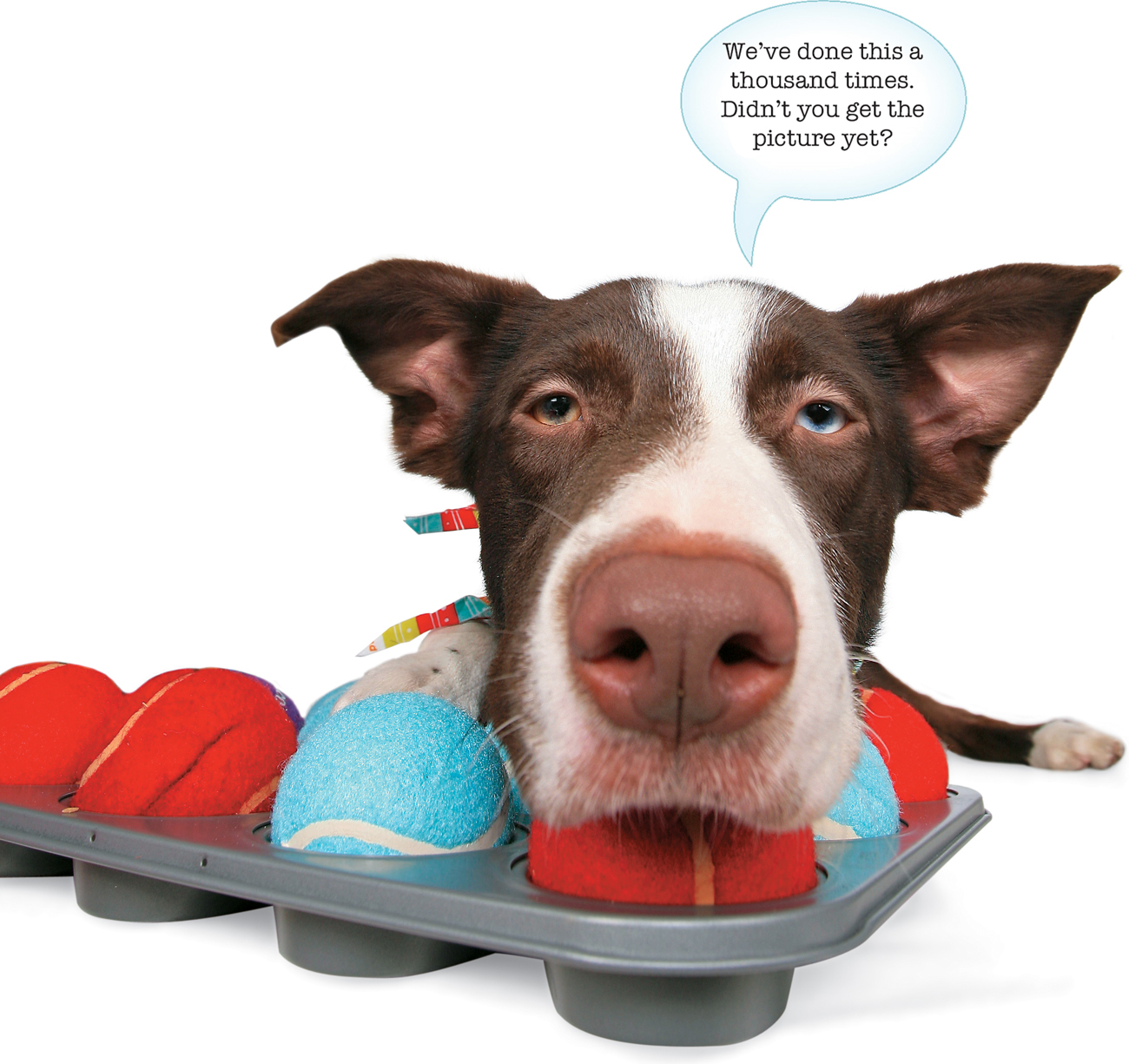

We’ve done this a thousand times. Didn’t you get the picture yet?
TIP:
With a very enthusiastic dog, you might need to hold the muffin tin in place. With a reluctant dog, put treats in every cup and put balls over only half of the cups.
EQUIPMENT:
Use an ordinary muffin tin and a dozen tennis balls.

TIP:
Supervise your dog to make sure he does not try to eat the towel. For less tenacious dogs, simply roll up the towel with the treats and do not tie it in a knot.
EQUIPMENT:
Use a thin dish towel, or cut an old towel into strips to make it less bulky.
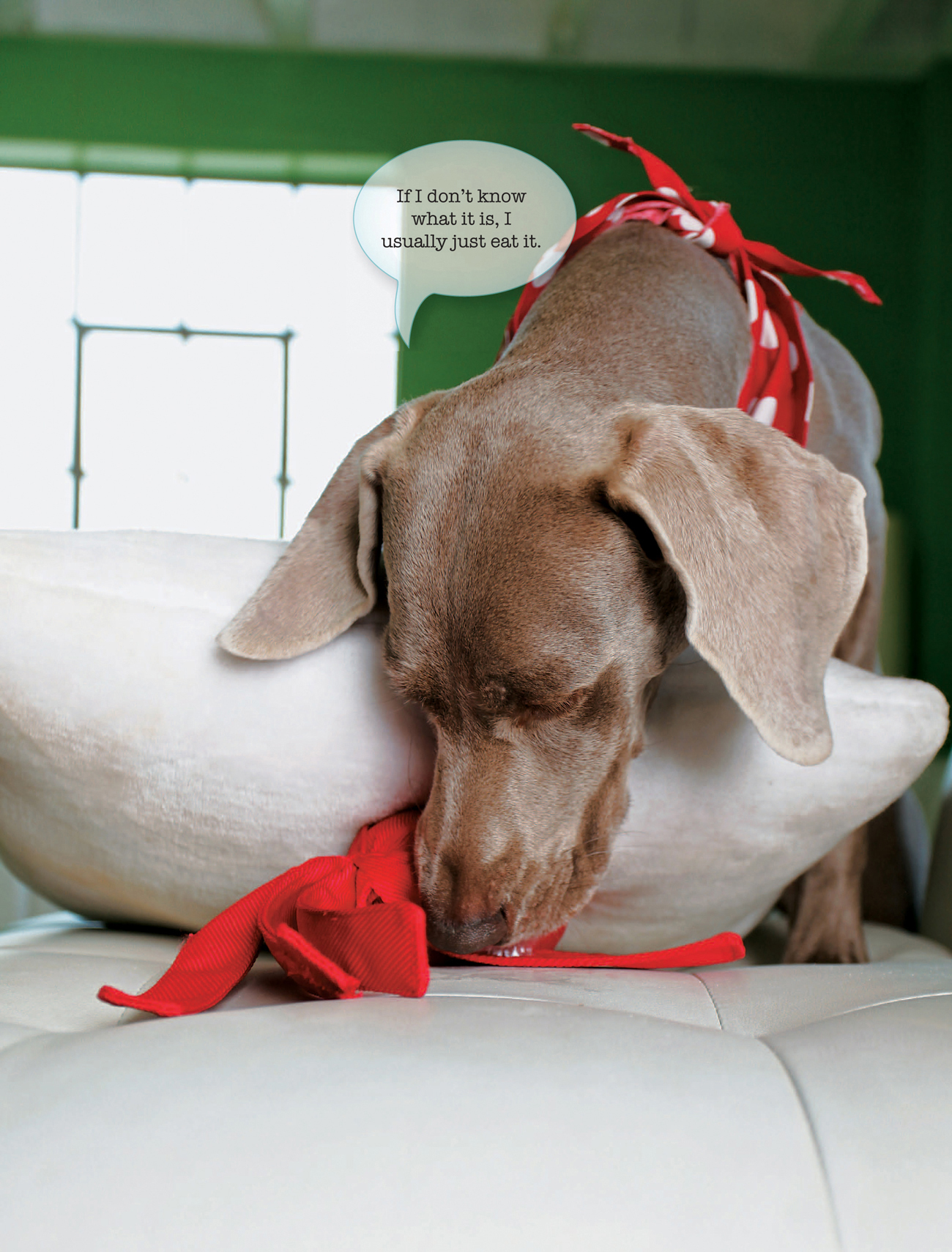
If I don’t know what it is, I usually just eat it.
TIP:
If your dog seems confused, encourage him by pointing toward the treat. When you increase the difficulty, make sure your dog is still having good success, as you don’t want him to become frustrated and give up.
EQUIPMENT:
If your dog really loves a specific toy, use that for the hidden treasure. Otherwise use small treats such as kibble, goldfish crackers, popcorn, or Cheerios cereal. For a low-calorie treat use raw fruits and vegetables (such as carrots, green beans, potatoes, broccoli, and apples.)

Umm . . . can I pick both?
TIP:
This trick is a favorite among dogs! If your dog nips at your hand, do not let him have the reward. Instead pull your hands away for a few seconds. When you present them again, say, “Gentle …”
EQUIPMENT:
Use strong-smelling treats such as hot dogs, chicken, steak, ham, or cheese.
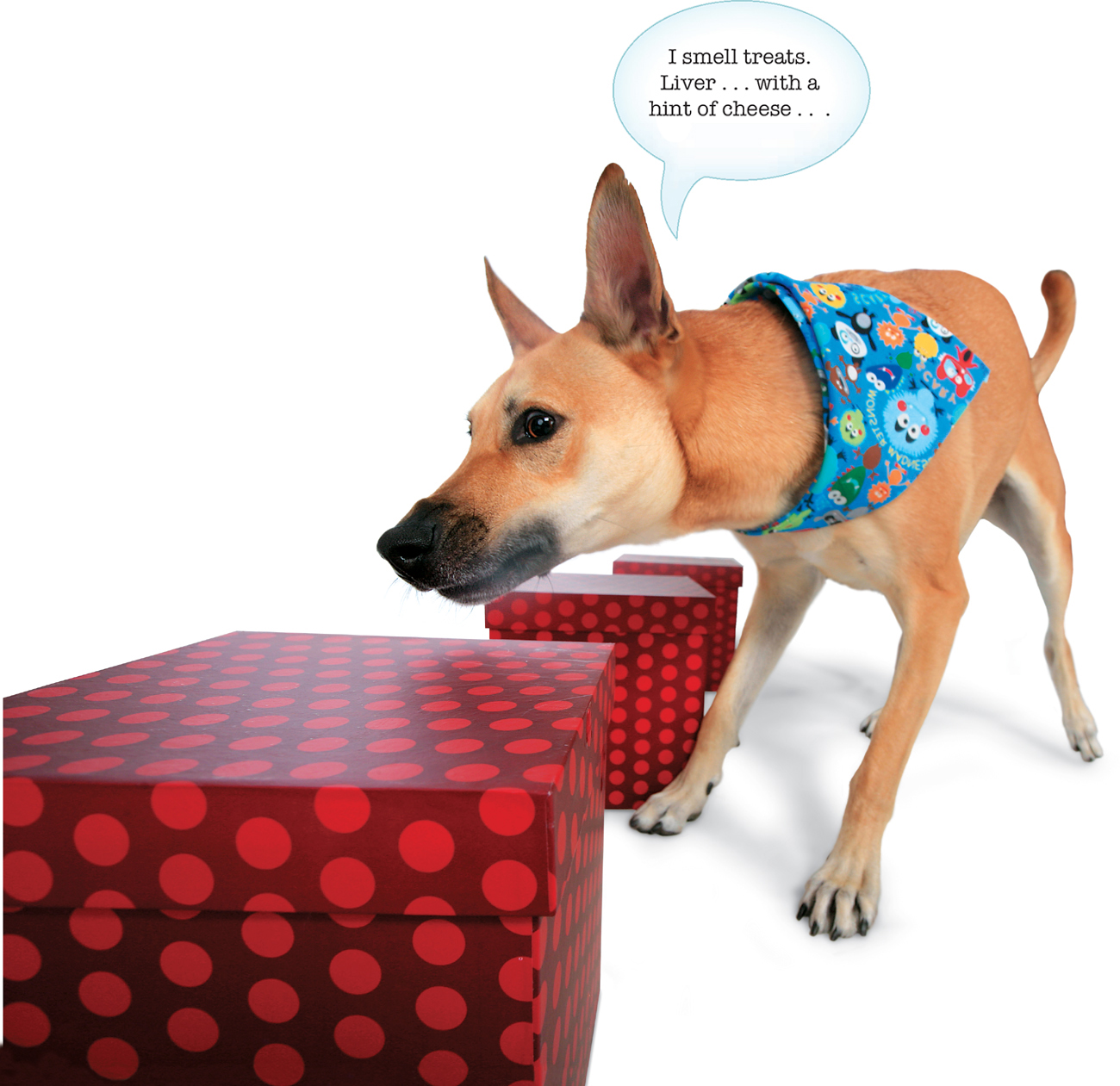
I smell treats. Liver . . . with a hint of cheese . . .

1 Set out three to six open boxes. Put some strong-smelling treats in a pouch or ventilated container (so your dog can’t eat them). Hide the treat container in one of the boxes and mix them up so your dog doesn’t know which box has the “hide.”
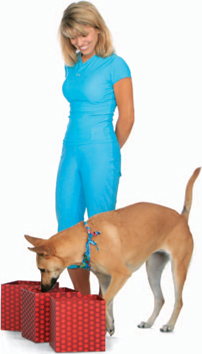
2 Release your dog to search the boxes. Don’t say anything while your dog searches, as it will distract him. If your dog needs encouragement, nonchalantly investigate the boxes yourself.
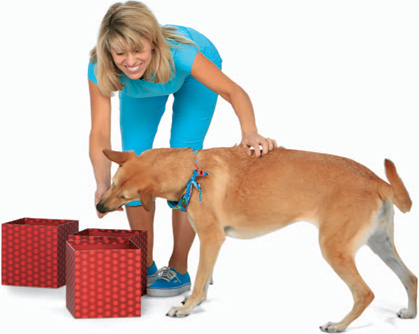
3 As soon your dog shows any interest in the correct box, enthusiastically praise him and give him a treat. (Always give the treat next to the correct box.)
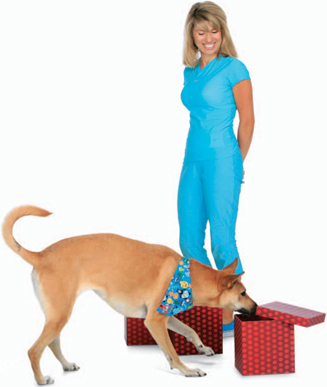
4 Increase the difficulty by closing (or partially closing) the boxes. Punch holes in the boxes for ventilation, so your dog can smell the treats inside.
TIP:
Nose work is a team sport; your dog finds the target scent, and you read his body language to know when he has found it. Watch your dog and learn to pick up on subtle body and breathing changes that indicate that he is on the trail of his target. Keep your sessions short and fun.
EQUIPMENT:
A variety of containers can work for this game: cardboard boxes, plastic food storage containers with holes punched in them, or upturned flower pots. It is helpful, but not imperative, for the containers to be identical.

Sometimes I’m in a hurry so I just knock them all over at once.

1 Start with just one pail. Rub the inside with a treat, or tape a treat to the inside against the scent hole. Show your dog as you place a treat on the floor and cover it with the pail.
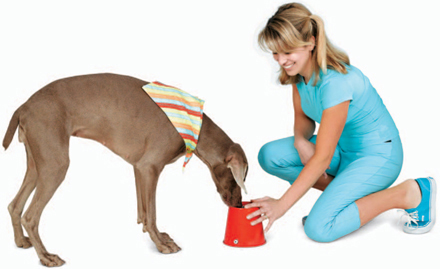
2 Encourage your dog to “find it!” When he noses or paws the pail, say, “Good!” and lift the pail, allowing him to get the treat.
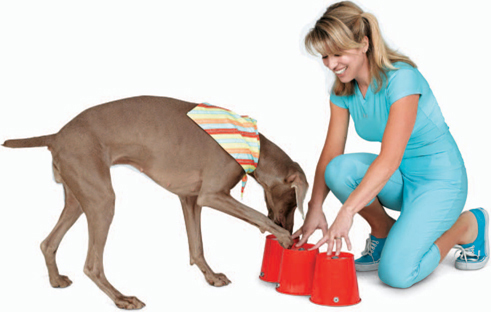
3 Add two more pails. You may have to hold them down so that your dog doesn’t knock them over. If he indicates an incorrect pail, do not lift it, but encourage him to “keep looking.”
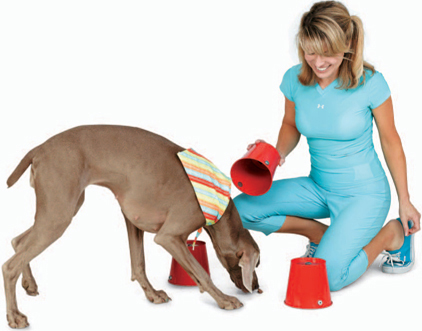
4 When your dog shows significant interest in the correct pail, say, “Good!” and lift it.
TIP:
This game can be confusing for your dog at first, so be gentle and avoid saying “no.” If your dog loses interest, quickly lift the pail to reveal the treat, and replace the pail. Always end this game on a successful attempt to keep your dog motivated and looking forward to the next time!
EQUIPMENT:
Use three identical pails which have a hole in their base to allow your dog to smell the contents. Heavy clay flower pots work well, as they have a hole in their base and won’t overturn easily.


1 Start by teaching your dog to Fetch (page 144). Set out three unscented balls. Scent one by rubbing it in your palms, and also with some of your treats. (Remember to mark the balls so you can tell which is the scented one!)
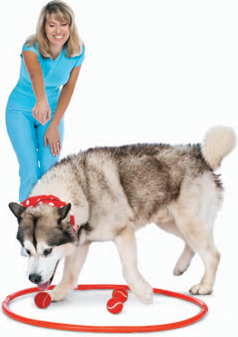
2 Point to the balls and instruct your dog to, “Find mine, fetch!” If your dog starts to fetch a wrong ball, keep pointing to and looking at the other balls, and say encouragingly, “Find mine!”
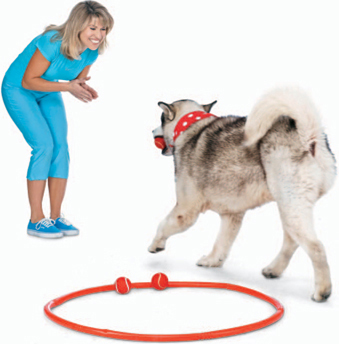
3 As soon as your dog puts his mouth on the correct ball, encourage him back to you, saying, “Good boy, bring it here.” Give him a treat when he brings the correct ball.
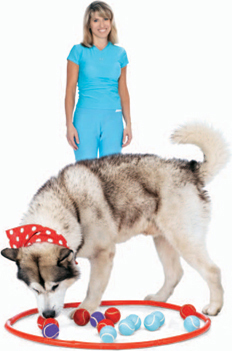
4 Fairly soon, increase the number of balls in the set. Once your dog starts to understand the goal, it will be helpful for you to keep quiet, as this will give him the confidence to work independently.
TIP:
Some dogs get the hang of this game in ten minutes. All dogs, however, will go through periods of doubt, where they regress. Know that this is part of the learning process and do not become frustrated and do not reprimand your dog for choosing incorrectly. Instead, just encourage him to go back and find the correct ball.
EQUIPMENT:
The tennis balls must be scent-free, so handle them with tongs and air them out for a day between uses. Use a hoop to confine them so that they don’t roll around the room.

Sometimes I help find the kitty when she’s lost.

1 Your dog will be most motivated to search for people he is bonded with, such as family members. Hold your dog while the other person hides nearby; perhaps behind a piece of furniture.
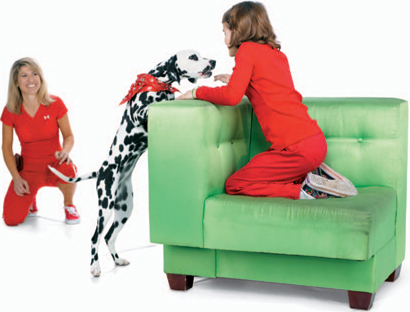
2 Tell your dog to “find [person’s name]!” The hiding person can help by calling to the dog. When your dog reaches them, the person gives a treat to your dog.
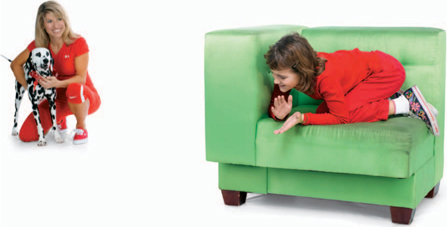
3 Gradually use more difficult hiding spots, such as behind an open door, in the shower, or in a partially open closet. Always give a treat or an enthusiastic play session as a reward for your dog finding his target.
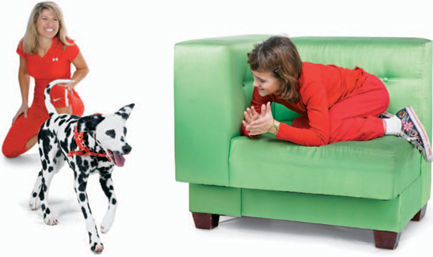
4 Your dog will learn to use his nose to scent for the person. He will even be able to scent the path that the person walked to their hiding place (you can try to fool your dog by walking into multiple rooms before hiding!).
TIP:
Dogs love this game! When the dog is busy getting his reward from one person, the other person can then hide, and you can play again with the roles reversed.

I think the hot dogs went this way.

1 Have your dog wait in the car while you walk a 50-meter (164 feet) straight line, scuffing your feet along the way. As you walk, drop strong-smelling treats every few steps.
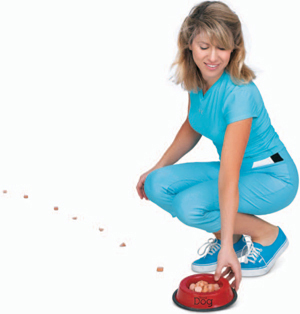
2 Place a big reward, such as a big dog biscuit or a favorite toy, at the end of the trail.
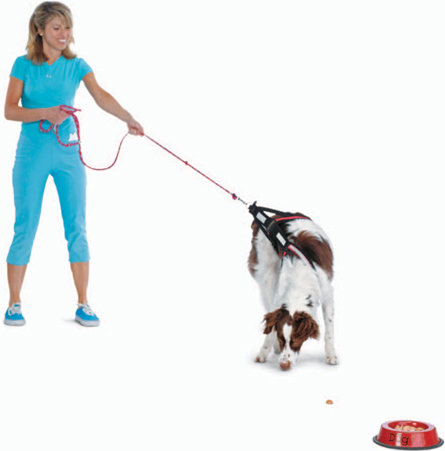
3 Start your dog at the beginning of the trail and allow him to pull you along the trail as he gobbles up the treats.

4 Let your dog find his big reward at the end!
TIP:
If your dog veers off track, be aware that the scent may be traveling on the breeze, and he may still be following the trail. As your dog improves, space the treats farther apart and put gradual bends in your track.
EQUIPMENT:
Outfit your dog in a harness and 12-foot (3.7 m) lead. Lay your track in moist grass, as it holds more scent and will be easier for your dog to follow. Use garden flags to remind you of the path you traveled.

I have a supersecret message to deliver!

1 Play this game with two people that your dog is bonded with, such as family members. Start in a boring environment, such as your home or yard. Separate and send the dog to the other person, saying, “Find [person’s name]!”
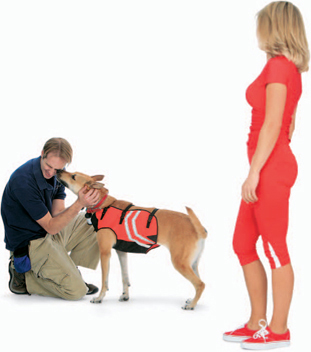
2 As the dog approaches him, the recipient should clap and encourage the dog. When the dog arrives, the recipient gives the dog enthusiastic praise and a handful of yummy treats.
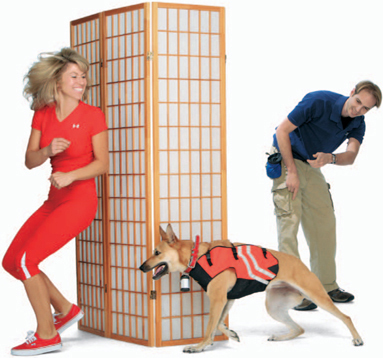
3 Now make it more difficult. Have the other person hold your dog while you run away and disappear around a corner. Can your dog still find you?
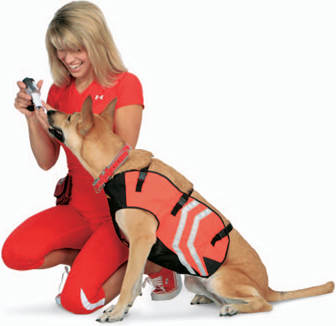
4 After you’ve sent your dog, take that opportunity to hide yourself in a new spot. Keep the game going, sending your dog back and forth between people.
TIP:
As your distance increases, your dog will rely more upon his scenting ability to find you and will track the path you walked. This exercise can come in handy if you ever lose your spouse or child!
EQUIPMENT:
No piece of equipment is absolutely necessary for this game; however, some items that may be helpful are a blaze-orange dog vest, a collar message canister, a GPS tracking collar, and cellphones or radios.